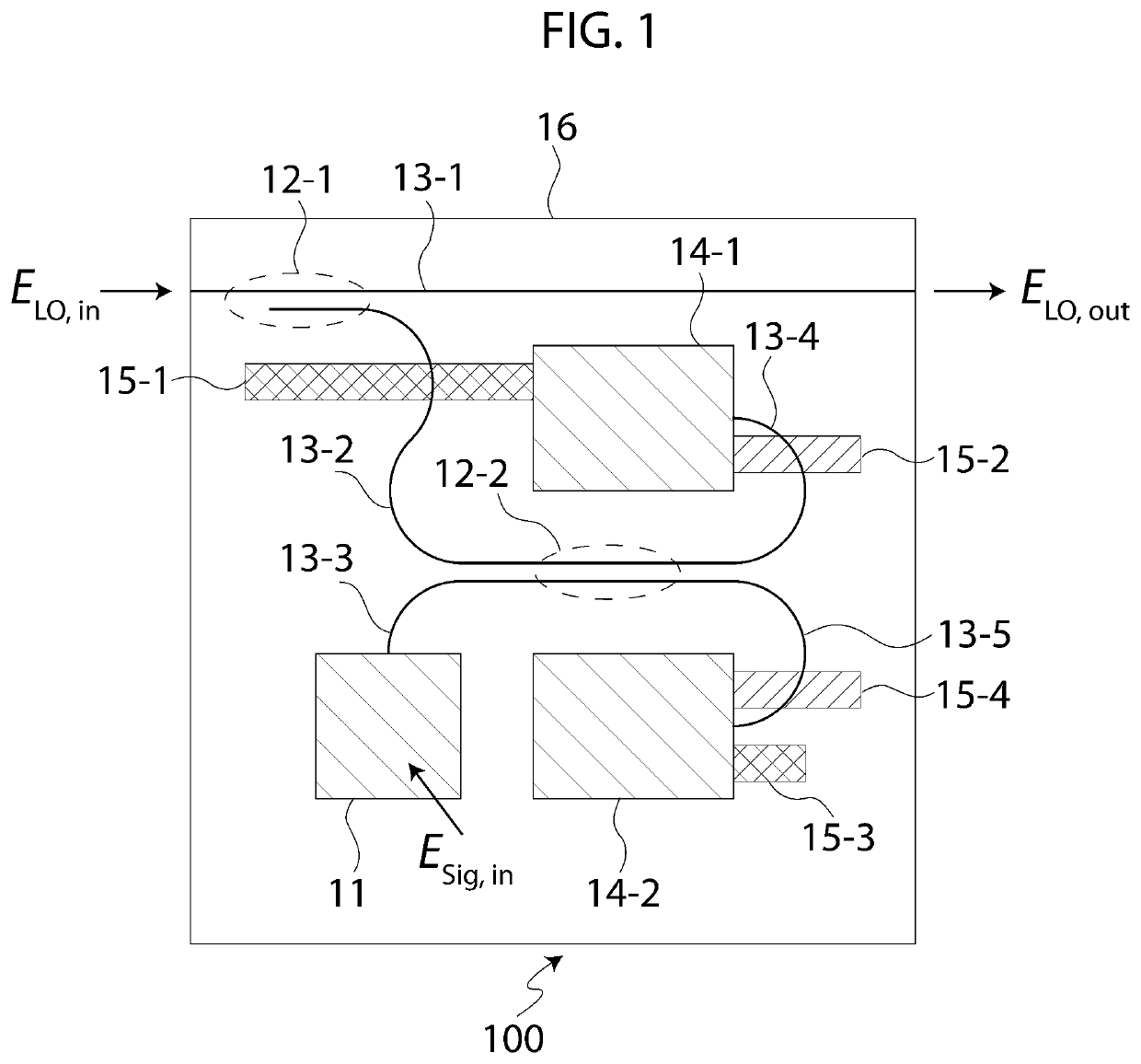Photonic coherent detection array
a detection array and photonic technology, applied in the field of optical coherent detection, can solve the problems of affecting the efficiency of coherent detection, limiting the number of pixels in the detection array, and the described nci scheme may be limited to a few pixels, so as to facilitate the stacking of detection units and the scalability of coherent detection array, and high frame rate operation. the effect of high pixel coun
- Summary
- Abstract
- Description
- Claims
- Application Information
AI Technical Summary
Benefits of technology
Problems solved by technology
Method used
Image
Examples
first preferred embodiment
[0025]A coherent detection unit 100 according to the present preferred embodiment will be described with reference to FIG. 1, which illustrates a plan view of the coherent detection unit 100. The coherent detection unit 100 illustrated in FIG. 1 is configured to include a free-space-to-waveguide coupler 11, optical couplers 12-1 and 12-2, waveguides 13-1, 13-2, 13-3, 13-4 and 13-5, photodetectors 14-1 and 14-2, and electrodes 15-1, 15-2, 15-3 and 15-4. The coherent detection unit 100 may also be configured to include additional components, such as one or more modulators and / or heaters, which may be used to modulate or modify the properties of the coherent detection unit. These additional components are not shown in FIG. 1. The coherent detection unit 100 may be integrated on a substrate 16 using optical waveguide technology.
[0026]The waveguide 13-1 is an optical waveguide having one end (incoming end) through which the local oscillator light ELO,in may be introduced, and having anot...
second preferred embodiment
[0035]Two examples of coherent detection arrays 200 and 210 according to the present preferred embodiment will be described with reference to FIGS. 2 and 3.
[0036]FIG. 2 illustrates a plan view of the coherent detection array 200. The coherent detection array 200 is configured to include plural units of the coherent detection unit 100 according to the embodiment illustrated in FIG. 1. In some aspects, the coherent detection array 200 may include other embodiments of the coherent detection units. In some aspects, the coherent detection array 200 may be constructed by concatenating plural units of the coherent detection unit 100 in a rectilinear configuration. In other aspects, embodiments of the coherent detection array may be constructed by concatenating plural units of the coherent detection unit 100 in geometries other than the rectilinear configuration. The coherent detection array 200 may be integrated on a substrate 26 using optical waveguide technology.
[0037]In some aspects of ...
third preferred embodiment
[0063]Two examples of coherent detection units 300 and 310 according to the present preferred embodiment will be described with reference to FIGS. 4 and 5.
[0064]FIG. 4 illustrates a plan view of the coherent detection unit 300. The coherent detection unit 300 illustrated in FIG. 4 is configured to include a free-space-to-waveguide coupler 31, optical couplers 32-1 and 32-2, waveguides 33-1, 33-2, 33-3 and 33-4, a photodetector 34, and electrodes 35-1 and 35-2. The coherent detection unit 300 may also be configured to include additional components, such as one or more modulators and / or heaters, which may be used to modulate or modify the properties of the coherent detection unit. These additional components are not shown in FIG. 4. The coherent detection unit 300 may be integrated on a substrate 36 using optical waveguide technology.
[0065]The coherent detection unit 300 is a modified version of the coherent detection unit 100 illustrated in FIG. 1. The coherent detection unit 300 may...
PUM
 Login to View More
Login to View More Abstract
Description
Claims
Application Information
 Login to View More
Login to View More - R&D
- Intellectual Property
- Life Sciences
- Materials
- Tech Scout
- Unparalleled Data Quality
- Higher Quality Content
- 60% Fewer Hallucinations
Browse by: Latest US Patents, China's latest patents, Technical Efficacy Thesaurus, Application Domain, Technology Topic, Popular Technical Reports.
© 2025 PatSnap. All rights reserved.Legal|Privacy policy|Modern Slavery Act Transparency Statement|Sitemap|About US| Contact US: help@patsnap.com



